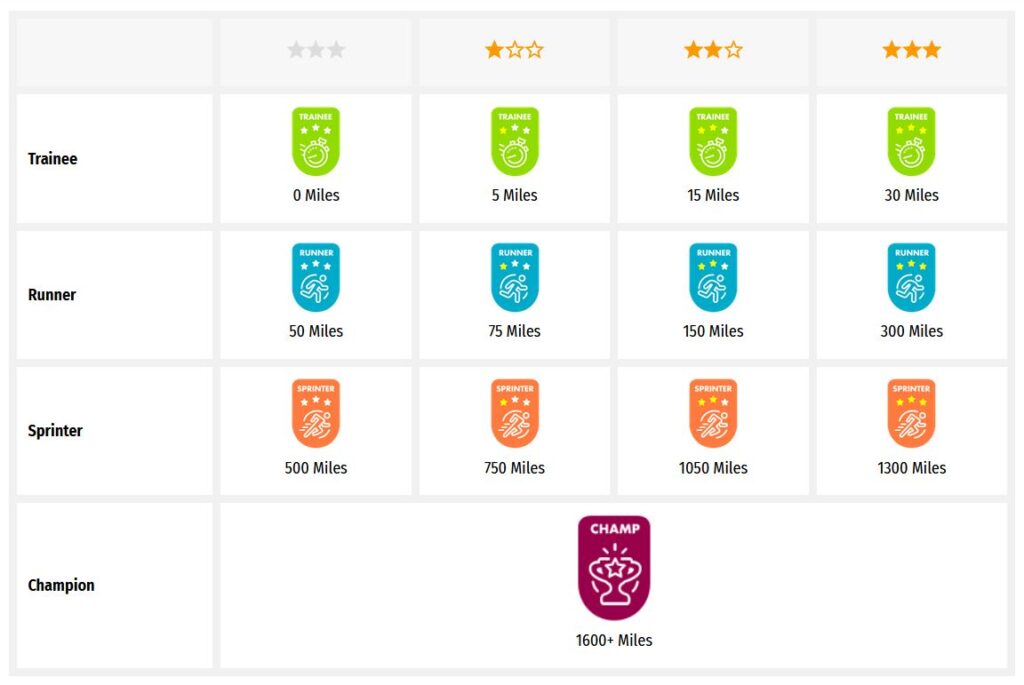Someone else is currently editing this document
Only one person can work on a document at a time
TRANSCRIPTION
This is a transcript of an interview conducted by Age Exchange as part of the Children of the Great War project funded by the Heritage Lottery Fund.
Age Exchange is a member of The Imperial War Museum First World War
Centenary Partnership.
www.childrenofthegreatwar.org.uk www.age-exchange.org.uk
If you wish to contact Age Exchange about this contribution, or access other
archive material from its the Children of The Great War project, please email
greatwar@age-exchange.org.uk
|
Title |
A brief history of the Voluntary Aid Detachment |
|
About: |
The Voluntary Aid Detachment Nurses club at Cavendish Square |
|
The story was shared at: |
The New Cavendish Club, London, UK |
|
On: |
Saturday 8th March 2014 |
|
By: |
Sonja Curtis |
|
AE Reference: |
NCC0001 |
Interview with Sonja Curtis
Sonja, can you just begin by telling us about your role here (at the New Cavendish Club)?
Ok well I'm a Membership Secretary here but I was also asked to start a charity to commemorate the VADS and all nurses that were killed during the two Great Wars. That's what we"re doing now. The Nursing War Appeal covers the First World War and the Second World War and the VADs started
before the First World War really.
I didn't know that...
Well I believe that you've really got to go back to Florence Nightingale and the Crimea War because, I
made a note of the date of this because I'm not good on dates. That happened in 1899. She went out
there - there were 38 nursing ladies, or ladies that knew a bit about nursing. 43 years later we had the
Second World War and I think mainly nurses volunteered from Commonwealth countries like Canada,
Australia, and New Zealand. The women actually wanted to go and nurse and help out in the World
War and Britain wasn't really keen to have them. I'm not sure how it happened. The Red Cross and St
John's then formed hospital trains and ships that went out there to collect the wounded soldiers and on
the way out they would take supplies and on the way back they'd bring back the injured. Those trains
and ships were staffed by nurses. Most of the nurses then were trained by the Army. The Red Cross did
do a fair amount but if you wanted to find nurses, they were normally in the Army.
There was a big centre there in Pimlico wasn't there?
That's right. My opinion is, I think it was the enormity of that situation that made the Government realise
that the medical facilities you need and personnel you need for a standing Army is totally different to the
amount of personnel you need during Wartime. Nothing really changes. They couldn't afford to keep
that number when they weren't in a Wartime situation.
I want to ask you about the club. You said it has another name.
Language(s) of Transcription
LOCATION
New Cavendish Club, 44 Cumberland Place, London (51.515213, -0.159505)
Wikidata Reference: Great Cumberland Place, undefined
ABOUT THIS DOCUMENT
Document Date
Document Type
Document Description
Language of Description
Keywords
People
Sonja Curtis
Florence Nightingale (Birth: 18/05/1820, Firenze - Death: 13/08/1910, London)
STORY INFORMATION
Title
A brief history of the Voluntary Aid Detachment
Source
UGC
Book
Contributor
europeana19141918:agent/3339d282f4d447802f29e6d48053aa5c
Date
1899
Type
Story
Language
eng
English
Country
Europe
DataProvider
Europeana 1914-1918
Provider
Europeana 1914-1918
Rights
http://creativecommons.org/publicdomain/zero/1.0/ http://creativecommons.org/licenses/by-sa/3.0/Year
1899
DatasetName
2020601_Ag_ErsterWeltkrieg_EU
Begin
1899
End
1899
Language
mul
Agent
The New Cavendish Club | europeana19141918:agent/3339d282f4d447802f29e6d48053aa5c
Lady Ampthill | europeana19141918:agent/6a48bae445cf0521d045ae5914ecd8a4
Created
2019-09-11T08:33:24.880Z
2020-02-25T08:34:24.380Z
1918
Provenance
COTGW_CAV
Story Description
Cornwall HallOfficial documentHome FrontIncome & expenditure recordsDinner menu, Cornwall HallCornwall Hall hospitalPhotographNurse AnsonMultiplepage from the New Cavendish Club's scrapbook (relating to Cornwall Hall)Letter regarding Queen AlexandraLetterWomenVAD nursesA patient convalescingMedicalPublicationNewspaper article: Lloyd GeorgeA Hymn for WartimeOtherWards 1 & 2Christmas 1916Easter 191751.27241000000001,0.19089800000006107the family groupprograme, Cornwall HallMemorabiliaNewspaper article; men aged 16 and 60, both woundedEntertainmentPoemPoem: 10 little VAD;sLetter regarding the CommandantNurse Hearson and Sister CrumpBookVAD ABC book (poems)'A' is for the artist who stuck on night duty, drew this by candlelight, wrecking her beauty'C' is for Canada, valant and true, whose sons make the Huns look decidedly blu'G' are the grouses one has to suppress, at being cut off from more picturesque dress'Quatermaster', (I'm thankful, aren't you, such a person exists because quagga won't do) 'W - The Woodbines they smoke by the score, like Oliver Twist we are asking for more'Z' is the Zeal that inspires ev'ry one, to make their own hospital second to noneSyringe, from the WWI archive at the New Cavendish ClubHypodermic tablets, from the WWI archive at the New Cavendish ClubOptical medical equipment from Cornwall HallArmistice Day...
TRANSCRIPTION
LOCATION
DESCRIPTION
PEOPLE
STORY INFO
TUTORIAL
This is a transcript of an interview conducted by Age Exchange as part of the Children of the Great War project funded by the Heritage Lottery Fund.
Age Exchange is a member of The Imperial War Museum First World War
Centenary Partnership.
www.childrenofthegreatwar.org.uk www.age-exchange.org.uk
If you wish to contact Age Exchange about this contribution, or access other
archive material from its the Children of The Great War project, please email
greatwar@age-exchange.org.uk
|
Title |
A brief history of the Voluntary Aid Detachment |
|
About: |
The Voluntary Aid Detachment Nurses club at Cavendish Square |
|
The story was shared at: |
The New Cavendish Club, London, UK |
|
On: |
Saturday 8th March 2014 |
|
By: |
Sonja Curtis |
|
AE Reference: |
NCC0001 |
Interview with Sonja Curtis
Sonja, can you just begin by telling us about your role here (at the New Cavendish Club)?
Ok well I'm a Membership Secretary here but I was also asked to start a charity to commemorate the VADS and all nurses that were killed during the two Great Wars. That's what we"re doing now. The Nursing War Appeal covers the First World War and the Second World War and the VADs started
before the First World War really.
I didn't know that...
Well I believe that you've really got to go back to Florence Nightingale and the Crimea War because, I
made a note of the date of this because I'm not good on dates. That happened in 1899. She went out
there - there were 38 nursing ladies, or ladies that knew a bit about nursing. 43 years later we had the
Second World War and I think mainly nurses volunteered from Commonwealth countries like Canada,
Australia, and New Zealand. The women actually wanted to go and nurse and help out in the World
War and Britain wasn't really keen to have them. I'm not sure how it happened. The Red Cross and St
John's then formed hospital trains and ships that went out there to collect the wounded soldiers and on
the way out they would take supplies and on the way back they'd bring back the injured. Those trains
and ships were staffed by nurses. Most of the nurses then were trained by the Army. The Red Cross did
do a fair amount but if you wanted to find nurses, they were normally in the Army.
There was a big centre there in Pimlico wasn't there?
That's right. My opinion is, I think it was the enormity of that situation that made the Government realise
that the medical facilities you need and personnel you need for a standing Army is totally different to the
amount of personnel you need during Wartime. Nothing really changes. They couldn't afford to keep
that number when they weren't in a Wartime situation.
I want to ask you about the club. You said it has another name.
- English (English)
This is a transcript of an interview conducted by Age Exchange as part of the Children of the Great War project funded by the Heritage Lottery Fund.
Age Exchange is a member of The Imperial War Museum First World War
Centenary Partnership.
www.childrenofthegreatwar.org.uk www.age-exchange.org.uk
If you wish to contact Age Exchange about this contribution, or access other
archive material from its the Children of The Great War project, please email
greatwar@age-exchange.org.uk
|
Title |
A brief history of the Voluntary Aid Detachment |
|
About: |
The Voluntary Aid Detachment Nurses club at Cavendish Square |
|
The story was shared at: |
The New Cavendish Club, London, UK |
|
On: |
Saturday 8th March 2014 |
|
By: |
Sonja Curtis |
|
AE Reference: |
NCC0001 |
Interview with Sonja Curtis
Sonja, can you just begin by telling us about your role here (at the New Cavendish Club)?
Ok well I'm a Membership Secretary here but I was also asked to start a charity to commemorate the VADS and all nurses that were killed during the two Great Wars. That's what we"re doing now. The Nursing War Appeal covers the First World War and the Second World War and the VADs started
before the First World War really.
I didn't know that...
Well I believe that you've really got to go back to Florence Nightingale and the Crimea War because, I
made a note of the date of this because I'm not good on dates. That happened in 1899. She went out
there - there were 38 nursing ladies, or ladies that knew a bit about nursing. 43 years later we had the
Second World War and I think mainly nurses volunteered from Commonwealth countries like Canada,
Australia, and New Zealand. The women actually wanted to go and nurse and help out in the World
War and Britain wasn't really keen to have them. I'm not sure how it happened. The Red Cross and St
John's then formed hospital trains and ships that went out there to collect the wounded soldiers and on
the way out they would take supplies and on the way back they'd bring back the injured. Those trains
and ships were staffed by nurses. Most of the nurses then were trained by the Army. The Red Cross did
do a fair amount but if you wanted to find nurses, they were normally in the Army.
There was a big centre there in Pimlico wasn't there?
That's right. My opinion is, I think it was the enormity of that situation that made the Government realise
that the medical facilities you need and personnel you need for a standing Army is totally different to the
amount of personnel you need during Wartime. Nothing really changes. They couldn't afford to keep
that number when they weren't in a Wartime situation.
I want to ask you about the club. You said it has another name.
Language(s) of Transcription
English Translation
Transcription History
This is a transcript of an interview conducted by Age Exchange as part of the Children of the Great War project funded by the Heritage Lottery Fund. Age Exchange is a member of The Imperial War Museum First World War Centenary Partnership. www.childrenofthegreatwar.org.uk www.age-exchange.org.uk If you wish to contact Age Exchange about this contribution, or access other archive material from its the Children of The Great War project, please email greatwar@age-exchange.org.uk Title A brief history of the Voluntary Aid Detachment About: The Voluntary Aid Detachment Nurses club at Cavendish Square The story was shared at: The New Cavendish Club, London, UK On: Saturday 8th March 2014 By: Sonja Curtis AE Reference: NCC0001 Interview with Sonja Curtis Sonja, can you just begin by telling us about your role here (at the New Cavendish Club)? Ok well I'm a Membership Secretary here but I was also asked to start a charity to commemorate the VADS and all nurses that were killed during the two Great Wars. That's what we"re doing now. The Nursing War Appeal covers the First World War and the Second World War and the VADs started before the First World War really. I didn't know that... Well I believe that you've really got to go back to Florence Nightingale and the Crimea War because, I made a note of the date of this because I'm not good on dates. That happened in 1899. She went out there - there were 38 nursing ladies, or ladies that knew a bit about nursing. 43 years later we had the Second World War and I think mainly nurses volunteered from Commonwealth countries like Canada, Australia, and New Zealand. The women actually wanted to go and nurse and help out in the World War and Britain wasn't really keen to have them. I'm not sure how it happened. The Red Cross and St John's then formed hospital trains and ships that went out there to collect the wounded soldiers and on the way out they would take supplies and on the way back they'd bring back the injured. Those trains and ships were staffed by nurses. Most of the nurses then were trained by the Army. The Red Cross did do a fair amount but if you wanted to find nurses, they were normally in the Army. There was a big centre there in Pimlico wasn't there? That's right. My opinion is, I think it was the enormity of that situation that made the Government realise that the medical facilities you need and personnel you need for a standing Army is totally different to the amount of personnel you need during Wartime. Nothing really changes. They couldn't afford to keep that number when they weren't in a Wartime situation. I want to ask you about the club. You said it has another name.
This is a transcript of an interview conducted by Age Exchange as part of the Children of the Great War project funded by the Heritage Lottery Fund. Age Exchange is a member of The Imperial War Museum First World War Centenary Partnership. www.childrenofthegreatwar.org.uk www.age-exchange.org.uk If you wish to contact Age Exchange about this contribution, or access other archive material from its the Children of The Great War project, please email greatwar@age-exchange.org.uk Title A brief history of the Voluntary Aid Detachment About: The Voluntary Aid Detachment Nurses club at Cavendish Square The story was shared at: The New Cavendish Club, London, UK On: Saturday 8th March 2014 By: Sonja Curtis AE Reference: NCC0001 Interview with Sonja Curtis Sonja, can you just begin by telling us about your role here (at the Cavendish Club)? Ok well I'm a Membership Secretary here but I was also asked to start a charity to commemorate the VADS and all nurses that were killed during the two Great Wars. That's what we"re doing now. The Nursing War Appeal covers the First World War and the Second World war and the VADs started before the First World War really. I didn't know that... Well I believe that you've really got to go back to Florence Nightingale and the Crimea War because, I made a note of the date of this because I'm not good on dates. That happened in 1899. She went out there - there were 38 nursing ladies, or ladies that knew a bit about nursing. 43 years later we had the Second World War and I think mainly nurses volunteered from Commonwealth countries like Canada, Australia, and New Zealand. The women actually wanted to go and nurse and help out in the World War and Britain wasn't really keen to have them. I'm not sure how it happened. The Red Cross and St John's then formed hospital trains and ships that went out there to collect the wounded soldiers and on the way out they would take supplies and on the way back they'd bring back the injured. Those trains and ships were staffed by nurses. Most of the nurses then were trained by the Army. The Red Cross did do a fair amount but if you wanted to find nurses, they were normally in the Army. There was a big centre there in Pimlico wasn't there? That's right. My opinion is, I think it was the enormity of that situation that made the Government realise that the medical facilities you need and personnel you need for a standing Army is totally different to the amount of personnel you need during Wartime. Nothing really changes. They couldn't afford to keep that number when they weren't in a Wartime situation. I want to ask you about the club. You said it has another name.
This is a transcript of an interview conducted by Age Exchange as part of the Children of the Great War project funded by the Heritage Lottery Fund. Age Exchange is a member of The Imperial War Museum First World War Centenary Partnership. www.childrenofthegreatwar.org.uk www.age-exchange.org.uk If you wish to contact Age Exchange about this contribution, or access other archive material from its the Children of The Great War project, please email greatwar@age-exchange.org.uk Title A brief history of the Voluntary Aid Detachment About: The Voluntary Aid Detachment Nurses club at Cavendish Square The story was shared at: The New Cavendish Club, London, UK On: Saturday 8th March 2014 By: Sonja Curtis AE Reference: NCC0001 Interview with Sonja Curtis Sonja, can you just begin by telling us about your role here (at the Cavendish Club)? Ok well I'm a Membership Secretary here but I was also asked to start a charity to commemorate the VADS and all nurses that were killed during the two Great Wars. That's what we"re doing now. The Nursing War Appeal covers the First World War and the Second World war and the VADs started before the First World War really. I didn't know that... Well I believe that you've really got to go back to Florence Nightingale and the Crimea War because, I made a note of the date of this because I'm not good on dates. That happened in 1899. She went out there - there were 38 nursing ladies, or ladies that knew a bit about nursing. 43 years later we had the Second World War and I think mainly nurses volunteered from Commonwealth countries like Canada, Australia, and New Zealand. The women actually wanted to go and nurse and help out in the World War and Britain wasn't really keen to have them. I'm not sure how it happened. The Red Cross and St John's then formed hospital trains and ships that went out there to collect the wounded soldiers and on the way out they would take supplies and on the way back they'd bring back the injured. Those trains and ships were staffed by nurses. Most of the nurses then were trained by the Army. The Red Cross did do a fair amount but if you wanted to find nurses, they were normally in the Army. There was a big centre there in Pimlico wasn't there? That's right. My opinion is, I think it was the enormity of that situation that made the Government realise that the medical facilities you need and personnel you need for a standing Army is totally different to the amount of personnel you need during Wartime. Nothing really changes. They couldn't afford to keep that number when they weren't in a Wartime situation. I want to ask you about the club. You said it has another name.
This is a transcript of an interview conducted by Age Exchange as part of the Children of the Great War project funded by the Heritage Lottery Fund. Age Exchange is a member of The Imperial War Museum First World War Centenary Partnership. www.childrenofthegreatwar.org.uk www.age-exchange.org.uk If you wish to contact Age Exchange about this contribution, or access other archive material from its the Children of The Great War project, please email greatwar@age-exchange.org.uk Title A brief history of the Voluntary Aid Detachment About: The Voluntary Aid Detachment Nurses club at Cavendish Square The story was shared at: The New Cavendish Club, London, UK On: Saturday 8th March 2014 By: Sonja Curtis AE Reference: NCC0001 Interview with Sonja Curtis Sonja, can you just begin by telling us about your role here (at the Cavendish Club)? Ok well I'm a Membership Secretary here but I was also asked to start a charity to commemorate the VADS and all nurses that were killed during the two Great Wars. That's what we"re doing now. The Nursing War Appeal covers the First World War and the Second World war and the VADs started before the First World War really. I didn't know that... Well I believe that you've really got to go back to Florence Nightingale and the Crimea War because, I made a note of the date of this because I'm not good on dates. That happened in 1899. She went out there - there were 38 nursing ladies, or ladies that knew a bit about nursing. 43 years later we had the Second World War and I think mainly nurses volunteered from Commonwealth countries like Canada, Australia, and New Zealand. The women actually wanted to go and nurse and help out in the World War and Britain wasn't really keen to have them. I'm not sure how it happened. The Red Cross and St John's then formed hospital trains and ships that went out there to collect the wounded soldiers and on the way out they would take supplies and on the way back they'd bring back the injured. Those trains and ships were staffed by nurses. Most of the nurses then were trained by the Army. The Red Cross did do a fair amount but if you wanted to find nurses, they were normally in the Army. There was a big centre there in Pimlico wasn't there? That's right. My opinion is, I think it was the enormity of that situation that made the Government realise that the medical facilities you need and personnel you need for a standing Army is totally different to the amount of personnel you need during Wartime. Nothing really changes. They couldn't afford to keep that number when they weren't in a Wartime situation. I want to ask you about the club. You said it has another name.
Interview with Sonja Curtis Sonja, can you just begin by telling us about your role here (at the Cavendish Club)? Ok well I'm a Membership Secretary here but I was also asked to start a charity to commemorate the VADS and all nurses that were killed during the two Great Wars. That's what we"re doing now. The Nursing War Appeal covers the First World War and the Second World war and the VADs started before the First World War really. I didn't know that... Well I believe that you've really got to go back to Florence Nightingale and the Crimea War because, I made a note of the date of this because I'm not good on dates. That happened in 1899. She went out there - there were 38 nursing ladies, or ladies that knew a bit about nursing. 43 years later we had the Second World War and I think mainly nurses volunteered from Commonwealth countries like Canada, Australie, and New Zealand. The women actually wanted to go and nurse and help out in the World War and Britain wasn't really keen to have them. I'm not sure how it happened. The Red Cross and St John's then formed hospital trains and ships that went out there to collect the wounded soldiers and on the way out they would take supplies and on the way back they'd bring back the injured. Those trains and ships were staffed by nurses. Most of the nurses then were trained by the Army. The Red Cross did do a fair amoutn but if you wanted to find nurses, they were normally in the Army. There was a big centre there in Pimlico wasn't there? That's right. My opinion is, I think it was the enormity of that situation that made the Government realise that the medical facilities you need and personel you need for a standing Army is totally different to the amoutn of personnel you need during Wartime. Nothing really changes. They couldn't afford to keep that number when they weren't in a Wartime situation. I want to ask you about the club. You said it has another name.
Interview with Sonja Curtis Sonja, can you just begin by telling us about your role here (at the Cavendish Club)? Ok well I'm a Membership Secretary here but I was also asked to start a charity to commemorate the VADS and all nurses that were killed during the two Great Wars. That's what we"re doing now. The Nursing War Appeal covers the First World War and the Second World war and the VADs started before the First World War really. I didn't know that... Well I believe that you've really got to go back to Florence Nightingale and the Crimea War because, I made a note of the date of this because I'm not good on dates. That happened in 1899. She went out there - there were 38 nursing ladies, or ladies that knew a bit about nursing. 43 years later we had the Second World War and I think mainly nurses volunteered from Commonwealth countries like Canada, Australie, and New Zealand. The women actually wanted to go and nurse and help out in the World War and Britain wasn't really keen to have them. I'm not sure how it happened.
Interview with Sonja Curtis Sonja, can you just begin by telling us about your role here (at the Cavendish Club)? Ok well I'm a Membership Secretary here but I was also asked to start a charity to commemorate the VADS and all nurses that were killed during the two Great Wars. That's what we"re doing now. The Nursing War Appeal covers the First World War and the Second World war and the VADs started before the First World War really.
English Translation
Automatically Identified Enrichments
Verify Automatically Identified Enrichments
Verify Automatically Identified Locations
Verify Automatically Identified Persons
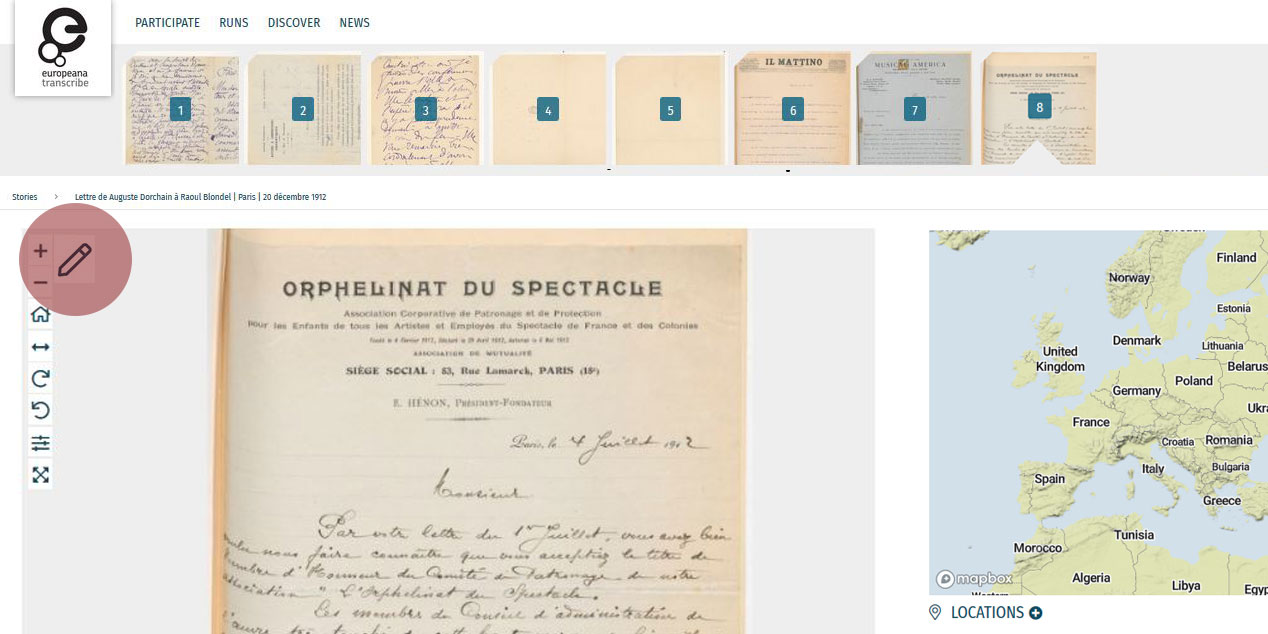
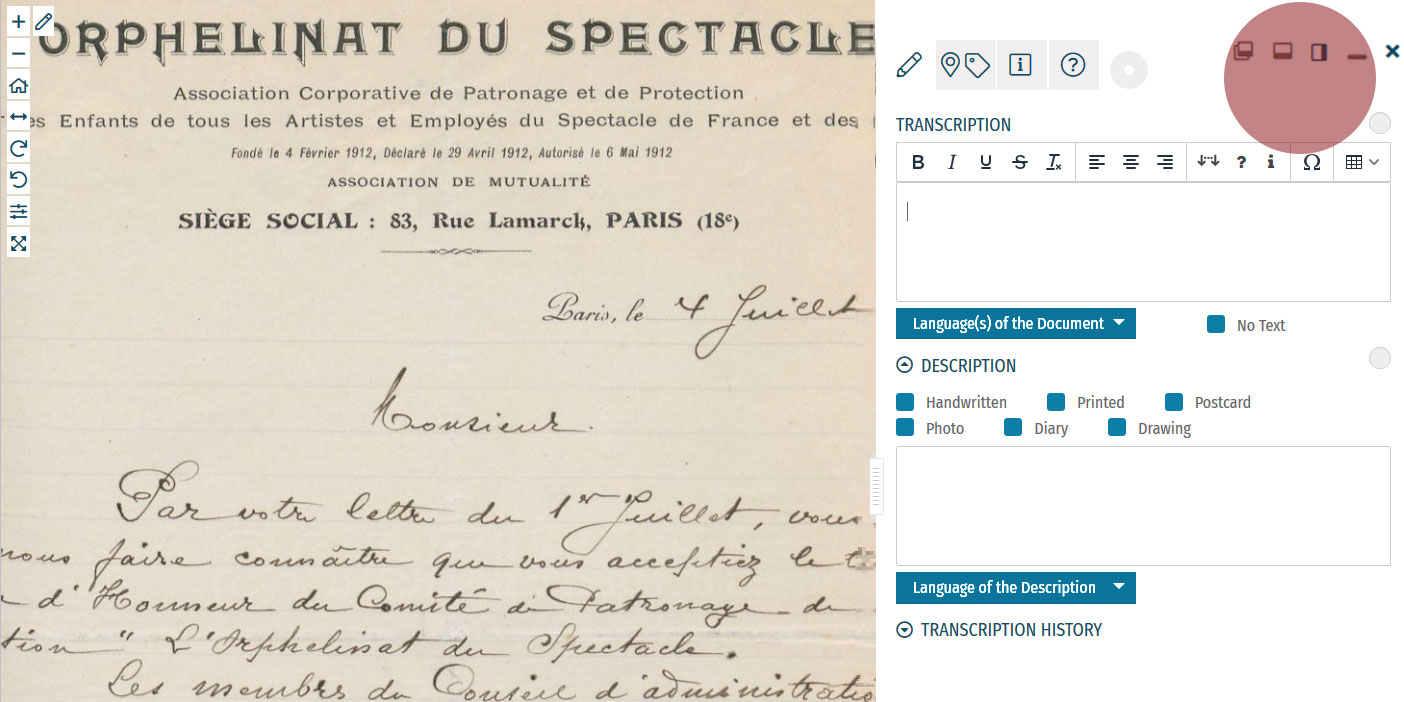
Enrichment Mode
Edit your workspace view by using the top-right menu.
You can have the white Activity Panel docked to the right (default) , to the bottom , or as an independent overlay . If you just want to view the image, you can hide the panel using the minimise button , and then re-open it with the pen button. Adjust the size and position of your Activity Panel according to your preferences.
You enrich documents by following a step-by-step process.
Make sure you regularly save your enrichments in each step to avoid the risk of losing your work.
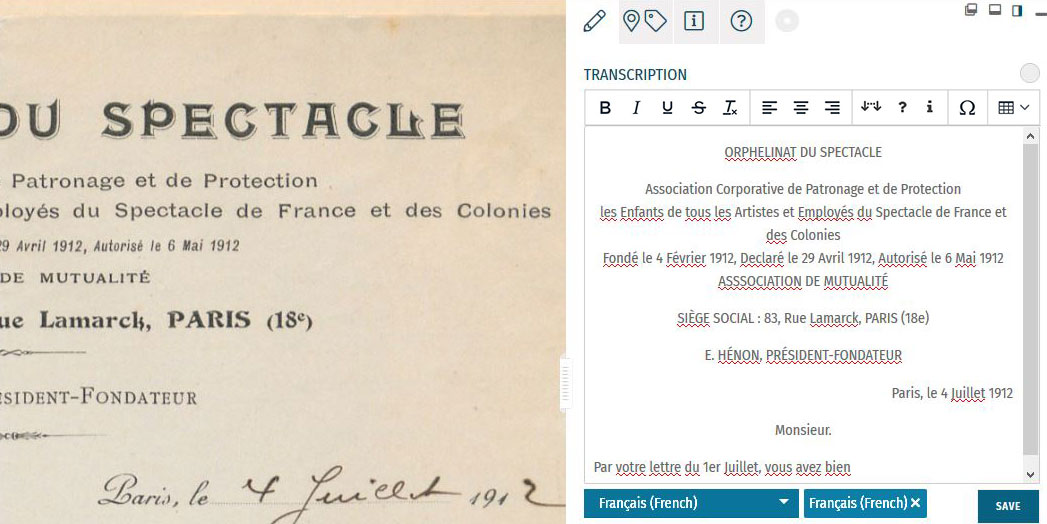
Step 1: Transcription
To start a transcription, select the transcription tab at the top menu of the Activity Panel. Click inside the box underneath the heading TRANSCRIPTION and start writing your transcription. When needed, use the toolbar to format your text and to add special characters and tables. A guide to the transcription toolbar is available in the Formatting section of this tutorial.
Identify the language(s) of the text using the dropdown list under the transcription box. You can select multiple languages at once.
If the item has no text to transcribe, tick the checkbox ‘No Text’.
Once you have finished your transcription, click SAVE.
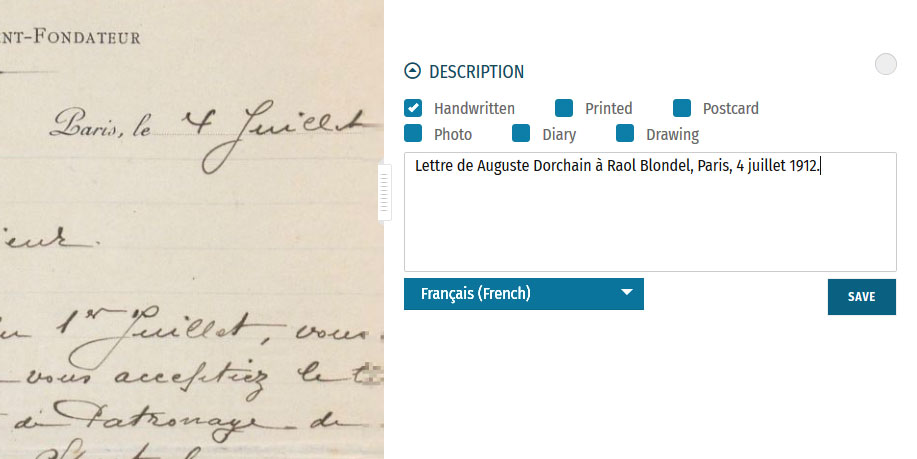
Step 2: Description
You can add a description to the item underneath the Transcription section.
The first task is to identify what type of document the item is: a handwritten or printed document, a postcard, photo, drawing and/or part of a diary. Tick the category which best applies to the item. Multiple categories can be selected at once.
The second task is to write a description of the contents. Click inside the box underneath the heading DESCRIPTION. Here, you can write what the item is, what it is about, and specify the images and objects that appear in the item.
Identify the language of the description text that you wrote using the dropdown list underneath. You can only select one language.
Once you have finished your description, click SAVE.
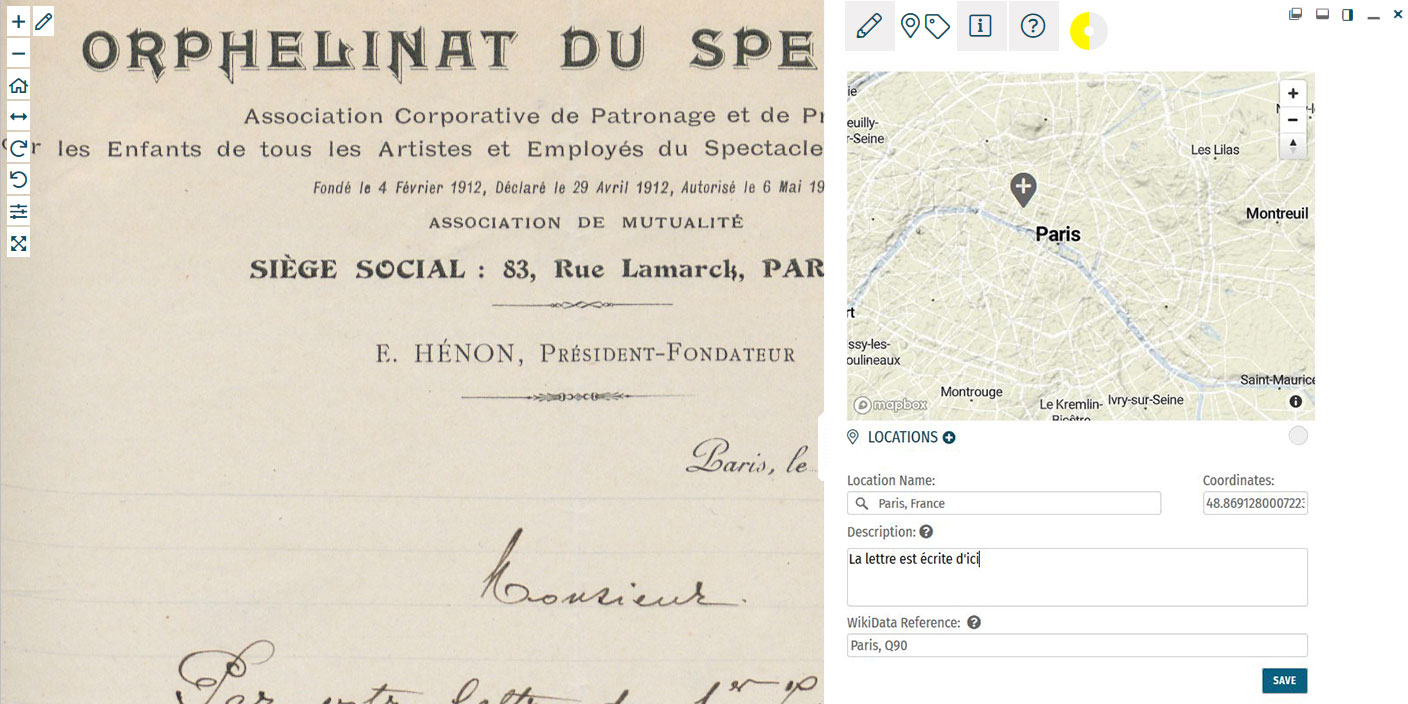
Step 3: Location
If you find a location mentioned or recognise a place in the item, you can create a geotag and pin it to the item map. Multiple locations can be attached to the item. To tag locations, select the tagging tab at the top menu of the Activity Panel. Click the plus next to the heading LOCATIONS. Type the location into the search bar and select the result that best applies. A new pin will be placed into the map. The location name should be a clear georeference, e.g. a country, city or address. Make adjustments to the location name if necessary. You can also adjust the position of the pin by dragging it on the map. If you want to add further details to the location, you can write a (short) description. This could include extra information about the geotag (e.g. the building name or a significant event that took place at the location) or the relevance of the place to the item (e.g. the hometown of the author). You can also add a Wikidata reference to link the location to a stable source. Search for the reference using the Wikidata fields. Once you have finished your location tag, click SAVE. You can find the place(s) tagged to the item in grey at the bottom of the Location(s) section.Step 4: Tagging
Below the Locations section is the Tagging section, where you can add the following annotations:
 Document Date:
Document Date:Here, you can add dates that correspond to the item. This could include the dates mentioned in the text (e.g. in diary pages), the date of a related historical event (e.g. the end of WWI), or when the item was created (e.g. from a dated signature on an illustration). You can either define this as a single date or as a longer time frame.
To tag dates to the item, write the start and end dates in DD/MM/YYYY format in the fields or select the dates by clicking on the calendar.
If you only have one date to add, insert the same date into both start and end fields.
If you don’t know the exact days, you can also tag the date on the scale of months (MM/YYYY) or years (YYYY).
Once you have finished your date tag, click SAVE DATE.
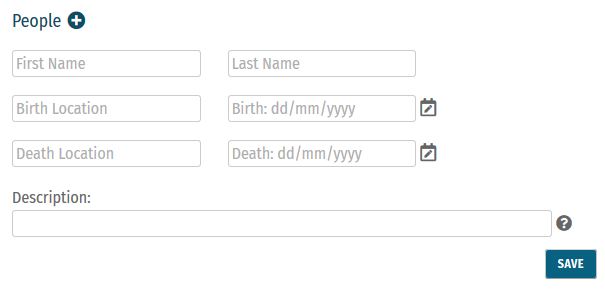 People:
People:People mentioned as creators or subjects in the item can also be tagged. Depending on the information you might have, you can enter the person’s first and last names, as well as their dates of birth and death. There is also the option to write a short description of the person, explaining who they are or their relevance to the item, e.g. the person’s occupation or their relation to another tagged person.
Multiple people can be tagged to one item.
Once you have finished your person tag, click SAVE.
 Keywords:
Keywords:Here, you can freely add keywords related to the topic and content of the item. This could include particular themes (e.g. art, music, war), subjects (e.g. children, cooking, France), or particular historical affiliations (e.g. 20th century, Austro-Hungarian Empire, Fall of the Iron Curtain).
Multiple keywords can be added and they can be written in any language.
Write your keyword tag into the field and click SAVE.
 Other Sources:
Other Sources:External websites with information about the item’s content can be linked here. This could include links to further data about a person mentioned, a particular historical event or links to digital versions of newspapers that appear in photos or clippings in a notebook.
To add a link, click the plus next to the heading ‘Other Sources’. Enter the URL into the Link field, and write a short description of this link in the Additional Description field.
Multiple links can be tagged to one item.
Once you have finished your tag, click SAVE.
Step 5: Mark for Review
Once you have saved your contribution, the task will automatically change to the Edit status. If you think the task is finished, you can mark it for review. Note that you have to be at Runner level or above to do this (see: Miles and Levels). Click on the yellow circle next to the section heading and select Review in the list that appears. The task now needs to go under Review by another volunteer.Formatting
Review
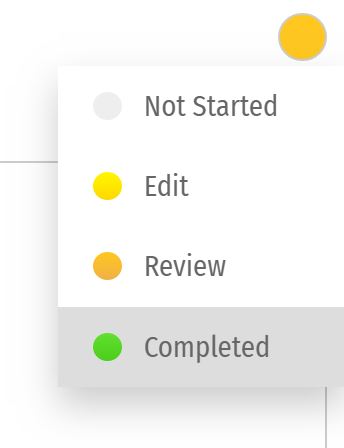 All enrichments need to be edited and reviewed by more than one volunteer to ensure that they are as accurate as possible.
Only Sprinters and Champions can edit tasks in the Review stage and mark them as Complete. (see: Miles and Levels)
You can review a task (Transcription, Description, Locations, or Tagging) when the circle next to the heading is coloured orange .
During the review process, pay close attention to the following requirements:
All enrichments need to be edited and reviewed by more than one volunteer to ensure that they are as accurate as possible.
Only Sprinters and Champions can edit tasks in the Review stage and mark them as Complete. (see: Miles and Levels)
You can review a task (Transcription, Description, Locations, or Tagging) when the circle next to the heading is coloured orange .
During the review process, pay close attention to the following requirements:
-
- Transcription: The complete text in the item has been properly transcribed and the transcription is formatted as accurately as possible. The correct language(s) are selected and the transcription contains no missing or unclear icons.
-
- Description: The description is accurate and detailed (especially items without text to transcribe, e.g. photos), and the appropriate categories have been ticked.
-
- Location(s): All locations have been correctly tagged. The location name is accurate and matches the coordinates and the pin on the map. The description is clear and concise, and the Wikidata reference (if any) is correct.
-
- Tagging: Document dates are completed and as precise as possible. All mentioned people are tagged and their data is correct. All added keywords are applicable to the item, and other sources have accurate information and functioning links.
Completion Statuses
| GREY |
| 1. NOT STARTED |
| Tasks have not been started. |
| YELLOW |
| 2. EDIT MODE |
| Tasks have been started, but not yet finished. Additions and edits can still be made. |
| ORANGE |
| 3. REVIEW |
| Tasks are finished, but need final review by Sprinter or Champion transcribers. |
| GREEN |
| 4. COMPLETED |
| Tasks have been fully completed and reviewed. No further changes need to be made. |
Miles and Levels
Transcribathon is a competitive marathon. You do not enrich documents alone, but compete and work with other volunteers to ensure the quality of your work. When you first create a Transcribathon account, you only have the ability to start and edit tasks. The more you enrich documents, the closer you become to advancing to a higher level, which can unlock abilities like reviewing and completing tasks.| Level | Abilities |
|---|---|
| Trainee | Basic abilities: start and edit tasks |
| Runner | Basic abilities, mark finished tasks for review |
| Sprinter | All Runner abilities, mark reviewed annotations as completed |
| Champion | All Sprinter abilities, mark reviewed transcriptions as completed |
| Tasks | Miles Received |
|---|---|
| Transcription | 1 Mile for every 300 characters transcribed |
| Description | 1 Mile for every 5 Descriptions added |
| Location | 1 Mile for every 5 Locations added |
| Tagging | 1 Mile for every 5 Tags added |
| Reviewing | 1 Mile for every 10 items marked as complete |
